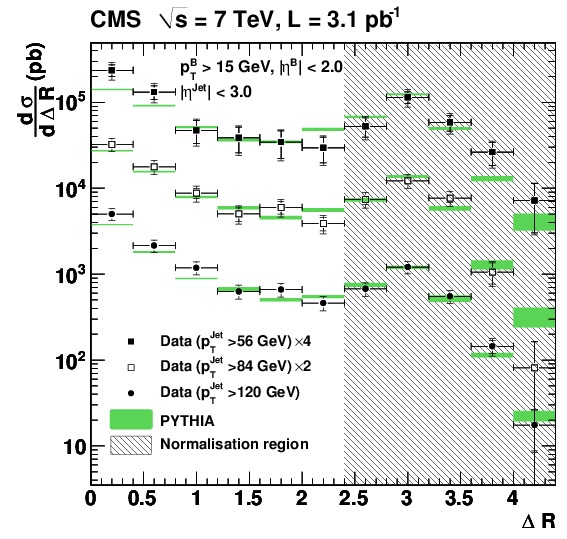Beauty production
Studying the production of beauty quarks is a very sensitive test of the validity of perturbative Quantum Chromodynamics (pQCD). We report here on some specific research topics, where our group has substantially contributed to the results:
B-production cross sections in p-p collisions at LHC

At the LHC, beauty quarks are predominantly produced in pairs through strong interaction, with a large cross section of the order of 100 μb. Measurements of the production dynamics provide not only sensitive tests of pQCD, but also, processes involving beauty constitute one of the main sources of background for many SM studies and most of the precision searches. Therefore, its detailed understanding is a crucial prerequisite for discovery of new physics. We have been involved on various levels in different studies of beauty production (ref. 9,10), in the design and implementation of b-tagging algorithms, and in particular in the development of a dedicated “Iterative Vertex Fitting” (IVF) method that depends on the tracks and vertices only.
Traditionally, the flight direction of B-mesons is reconstructed using the directions of b-jets. However, the jet methods cannot resolve small angular separations. Our method therefore has the advantage that it is capable of analyzing events where the b and bbar quarks are produced with a small opening angle and the corresponding B-hadrons are merged into one single jet. In particular, my group has analyzed the angular correlations (in 3D) between pairs of beauty hadrons produced in p-p collisions, for the first time down to a small angular separation at 7 TeV, reaching a very high angular resolution of order of 0.02 radians (see ref. 7). The measurements provide sensitivity to the various subprocesses contributing to beauty production. They have clearly demonstrated the large influence of higher-order processes such as gluon splitting in the collinear regime, which are notoriously difficult to theoretically predict with high precision.
Studies of angular correlations between the B-hadrons in B-Bbar production
Measurements of the angular correlations between beauty and anti-beauty hadrons produced in LHC pp collisions at sqrt(s)=7 TeV are presented. These results probe for the first time the small angular separation region and show sensitivity to collinear particle emission. The results are compared with predictions based on perturbative QCD calculations at leading and next-to-leading order.
B-production in electron-proton collisions at HERA
A substantial contribution by the ETH-group (at that time under the leadership of Prof. R.Eichler) to the H1 experiment, in close collaboration with PSI and the Univ. of Zuerich, was the construction of a central vertex detector, based on Silicon strips. Those particular properties could be well exploited when studying long lived particles, such as B- and D-hadrons (see ref. 6, 8). Our group substantially contributed to a variety of heavy flavour measurements. They include the determination of the charm and beauty structure functions of the proton and various differential production cross section measurements. We achieved to extract the gluon density distribution in the proton based completely on measurements of D-mesons in the final state.

